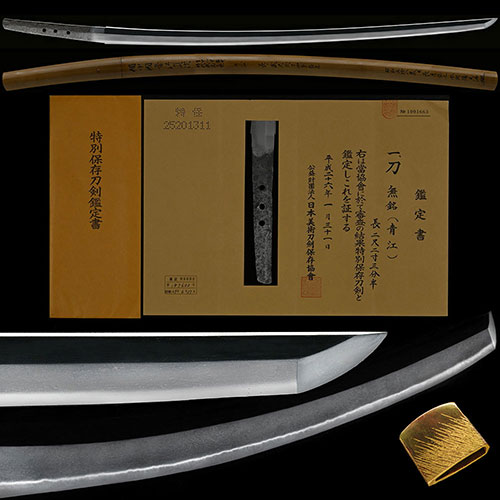
特別保存刀剣 Tokubetsuhozon Token
青江 太刀 Aoe Tachi
No.511996青江 貞次 生ぶ茎太刀 乱れ映り立つ美しい縮緬肌小足入り匂口明るい名品 二尺二寸三分Aoe Sadatsugu Ubu-Nakago Tachi Midare-Utsuritatsu beautiful Chirimen-hada Small-Ashi entered Nioikuchi is bright A masterpiece 67.7cm
- 極めKiwame
- 青江Aoe
- 登録証Registration
- 東京都 Tokyo 昭和46年6月27日 6/27/46(Showa)
- 時代Period
- 鎌倉初期承元頃Early Kamakura period around Jogen period
- 法量Size
-
刃長 67.7cm (二尺二寸三分) 反り 1.4cm
元幅 3.0cm 先幅 1.7cm 元重 0.58cm 鎬厚 0.68cm 先重 0.38cm 鋒長 2.5cm 茎長 17.8cm 重量 542gHachou 67.7cm (二尺二寸三分) Sori 1.4cm
Moto-Haba 3.0cm Saki-Haba 1.7cm Moto-Kasane 0.58cm Shinogi-Thikess 0.68cm Saki-Kasane 0.38cm Kissaki-Chou 2.5cm Nakago-Chou 17.8cm Weight 542g - 国Country
- 備中Bicchu
- 姿Shape
- 鎬造、庵棟、身幅広く、腰反り・踏ん張りつき、小鋒。Shinogidukuri, Iorimune, Wide Mihaba, Koshizori, Funbaritsuki, Small-Kissaki.
- 鍛Kitae
- 小板目肌つみ、小杢目肌交じり、地沸微塵に厚くつき、地景よく入り、乱れ映り立つ。Small-Itamehada-tsumi, Mixed small-Mokumehada, Jinie entered fine and thick, Chikei entered well, Midare-UTsuritatsu.
- 刃文Hamon
- 小互の目交じり、小足よく入り、小沸つき、匂口沈みごころ。Mixed Small-Gunome, Small-Ashi entered well, Small-Nie entered, Nioikuchi-shizumigokoro.
- 帽子Boushi
- 乱れ込んで先掃き掛けて返る。Midarekonde-Sakihakikakete-kaeru
- 茎Nakago
- 生ぶ、先栗尻、鑢目筋交、目釘孔三。Ubu, Sakikurijiri, Yasurimesujikai, Mekugiana are three(3).
- ハバキHabaki
- 金色絵一重。Kin-Iroe single.(Single layer of golden painting.)
- 説明Drscription
- 備中青江派は、備中高梁川下流域を中心に活躍した刀工群で、平安末期承安頃の安次・その子守次を祖として始まると伝え、平安末期から鎌倉中期頃までのものを古青江、それ以降を青江と大別している。貞次は、鎌倉初期承元ごろに活躍しているが、守次の子で、兄弟の恒次と共に後鳥羽院の御番鍛治に列する名工である。その名跡は、鎌倉前期嘉禄頃、鎌倉後期永仁頃・元応頃・嘉暦頃、南北朝時代にかけて続いているが、貞次といえば青江の上作の代名詞ともなっている。この刀は、身幅広く、腰反り・踏ん張りつき、先細く小鋒となる優美な姿を呈する生ぶ茎の公家太刀で、小板目肌つみ、小杢目肌交じり、地景よく入り、湯走り掛り、乱れ映り鮮やかに立つ所謂縮緬肌が美しい地鉄に、直刃調に、小互の目交じり、小足入り、小沸つき、匂口明るい名品である。Bichu-Aoe faction school is a group of swordsmiths who were active mainly in the lower reaches of the Bichu-Takahashi River.
It is roughly divided into.
Sadatsugu was active in the early Kamakura period around the Shogen period, and was Moritsugu's son, and was a master craftsman who was ranked as the goban blacksmith at Gotoba-in Temple along with his brother Tsunetsugu.
This name continues from around the Karoku period in the early Kamakura period, to the Eijin period in the late Kamakura period, around the Genou period, around the Karei period, and to the Nanbokucho period, but Sadatsugu has become synonymous with the works of Aoe.
This sword has wide Mihaba, Koshizori, Funbaritsuki, This is Ubu-Nakago's Kuge-Tachi, which has an elegant shape that tapers into a Small-Kissaki. Small-Itamehada-tsumi, Mixed small-Mokume-hada, Chikei entered well, Yubashiri-kakari, The so-called Chirimen-hada that stands vividly in Midare-Utsuri is beautiful in Jigane, Suguha-style, Mixed small-gunome, Small-Ashi entered, Small-Nie-tsuki, Nioikuchi is bright a masterpiece.





